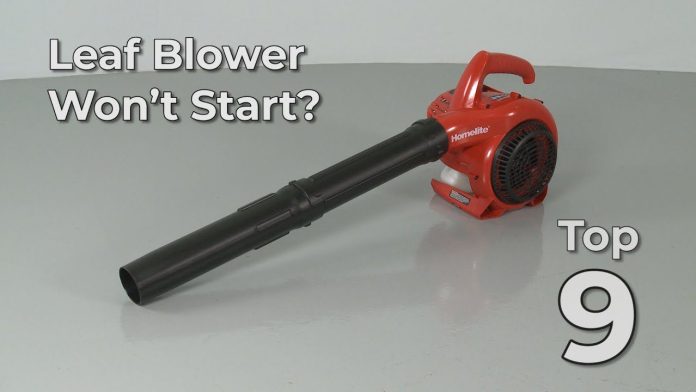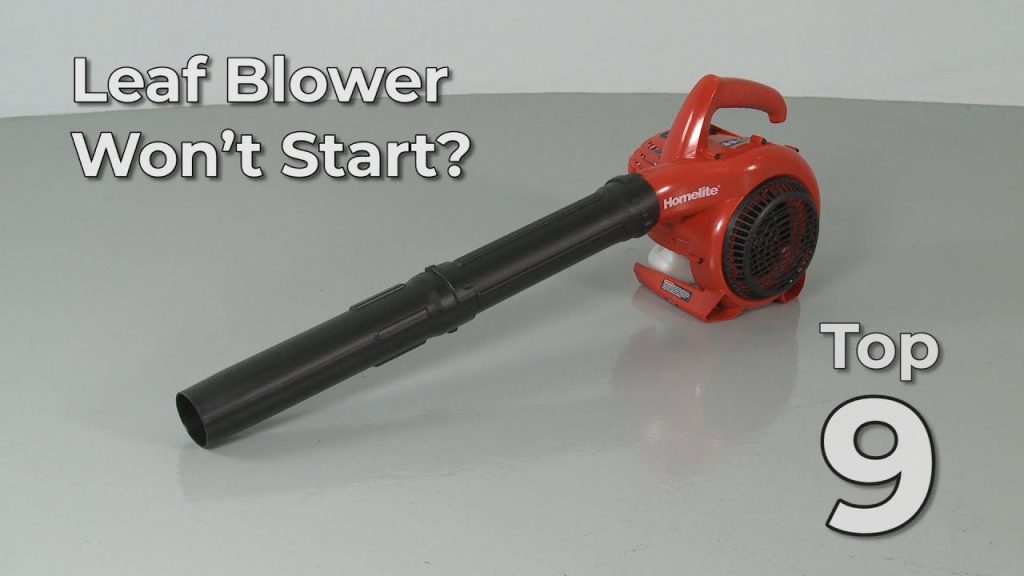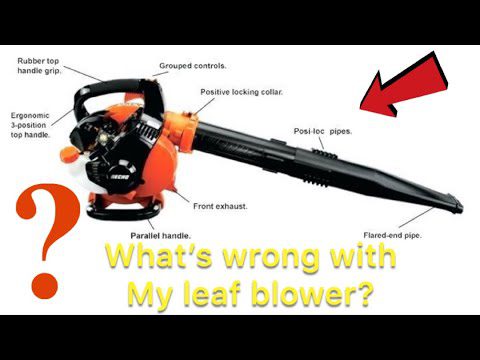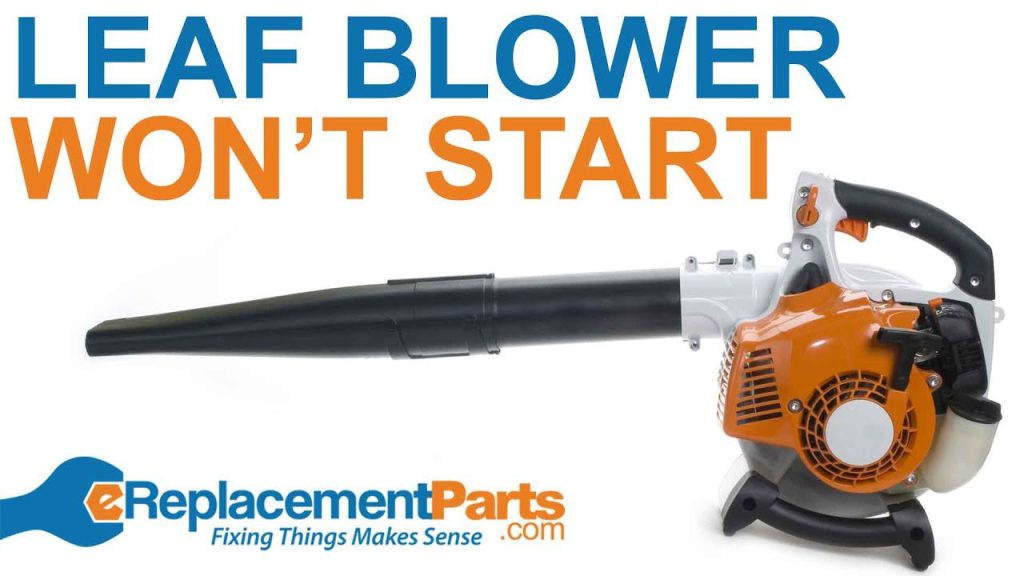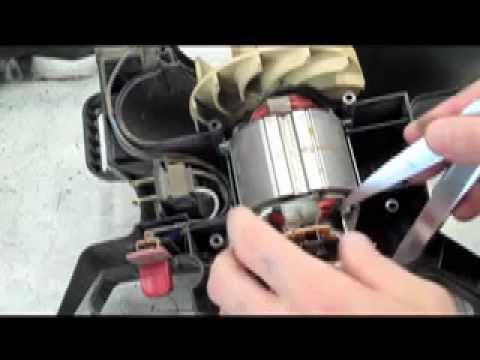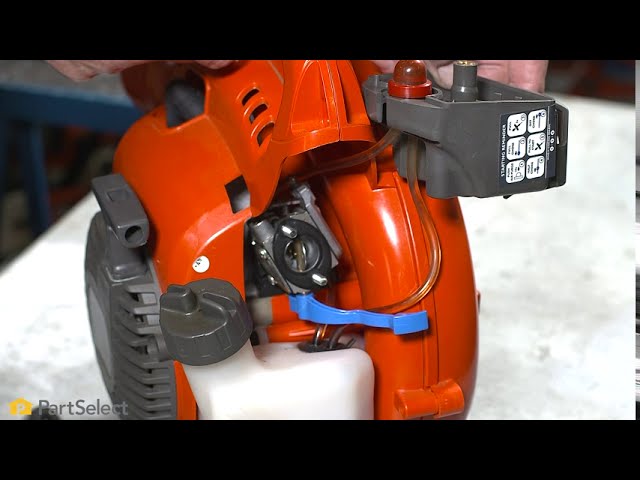Have you ever found yourself in a predicament where your trusty leaf blower suddenly loses its suction power? It can be frustrating when you’re all ready to tackle those pesky leaves, but your blower just doesn’t seem to be doing the job. Fear not, for we have got you covered. In this article, we will guide you through some simple troubleshooting steps to get your leaf blower back in action, sucking up those stubborn leaves like a champ. So, sit back, relax, and let’s get to the root of the problem!
This image is property of i.ytimg.com.
Check the Air Filters
Inspect the Air Filter
When troubleshooting a leaf blower with no suction, the first step is to check the air filters. The air filter is responsible for preventing dirt, debris, and other particles from entering the engine and causing damage. Over time, the air filter can become clogged with dirt and debris, which can restrict airflow and reduce the blower’s suction power. To inspect the air filter, locate the filter housing on the leaf blower and remove the air filter. Check for any signs of damage, such as tears or holes, and evaluate the level of dirt and debris accumulation.
Clean or Replace the Air Filter
If the air filter appears dirty or damaged, it is essential to clean or replace it to restore proper suction. Cleaning the air filter is a relatively straightforward process. Start by tapping the filter gently to dislodge any loose debris. Then, rinse the filter with clean water and allow it to air dry completely before reinstalling it. If the air filter is significantly dirty or damaged beyond repair, it is recommended to replace it with a new one. Most leaf blowers come with replacement filters readily available, making this task relatively easy.
Check the Pre-Filter
Some leaf blowers also feature a pre-filter, which acts as an additional layer of protection for the air filter. It is essential to inspect the pre-filter along with the main air filter. Ensure that the pre-filter is clean and free from any obstructions. If the pre-filter is dirty, clean it following the manufacturer’s instructions. In some cases, the pre-filter may need to be replaced entirely. By regularly checking and maintaining both the air filter and the pre-filter, you can ensure optimal suction performance from your leaf blower.
Examine the Impeller
Inspect the Impeller for Damage
The impeller is a crucial component of a leaf blower that creates the airflow necessary for suction. Over time, the impeller can suffer from wear and tear, which can lead to reduced suction power. To troubleshoot a leaf blower with no suction, it is essential to inspect the impeller for any signs of damage. Carefully remove the impeller cover and visually examine the impeller blades. Look for cracks, chips, or any other form of damage that may be affecting its functionality.
Remove any Debris or Clogs
In addition to inspecting for damage, it is also vital to remove any debris or clogs that may be obstructing the impeller. Leaves, twigs, and other debris can accumulate around the impeller, affecting its ability to create airflow and reducing suction. Use a small brush or compressed air to carefully remove any debris that may be stuck around the impeller blades. Take caution not to damage the impeller during this process, as it is a critical component of the leaf blower’s suction system.
Ensure Proper Impeller Function
After inspecting and cleaning the impeller, it is essential to ensure its proper function. Check that the impeller spins freely without any restrictions and does not wobble or make unusual noises. If you notice any irregularities or suspect that the impeller may be damaged, it is recommended to consult the manufacturer’s instructions or seek professional assistance to repair or replace the impeller. Proper impeller function is crucial for achieving optimal suction performance from your leaf blower.
Inspect the Vacuum Bag or Collection Container
Check for Holes or Tears in the Bag
For leaf blowers equipped with a vacuum function, the vacuum bag or collection container plays a significant role in the suction process. Over time, the bag or container can develop holes or tears, diminishing the leaf blower’s ability to maintain suction power. When troubleshooting a leaf blower with no suction, it is essential to inspect the vacuum bag or collection container for any signs of damage. Carefully examine the entire surface, looking for small holes, tears, or any weak points that may cause suction loss.
Ensure Proper Attachment
While inspecting the vacuum bag or collection container, it is crucial to ensure that it is properly attached to the leaf blower. Improper attachment can result in air leaks and reduced suction. Check the attachment points and confirm that they are secure and free from any debris or obstructions. If necessary, clean the attachment points to ensure a proper seal. Proper attachment is essential for maintaining consistent suction power throughout the leaf blowing or vacuuming process.
Empty the Bag
In some cases, a leaf blower may experience reduced suction due to an overfilled vacuum bag or collection container. When troubleshooting your leaf blower, make it a point to empty the bag if it is full. Leaves, grass clippings, and other debris can accumulate quickly, reducing the available space for airflow and limiting suction. Regularly emptying the bag or container during use will help maintain the leaf blower’s suction power and ensure efficient operation.
Check the Blower Tube or Nozzle
Inspect the Tube for Blockages
The blower tube or nozzle is responsible for directing the airflow generated by the leaf blower. Blockages in the tube can hinder the airflow and reduce suction. To troubleshoot a leaf blower with no suction, it is essential to inspect the blower tube for any blockages. Begin by detaching the tube from the leaf blower and visually inspecting the inside. Look for debris, leaves, or any other obstructions that may be obstructing the airflow.
Clean or Remove any Debris
If you find any blockages in the blower tube, the next step is to clean or remove the debris. Use a small brush, pipe cleaner, or compressed air to dislodge and remove any obstructions. Take care not to damage the tube or the leaf blower while performing this task. Once the tube is free from blockages, reattach it securely to the leaf blower. By ensuring a clear and unobstructed pathway for airflow, you can optimize the suction power of your leaf blower.
Ensure Proper Attachment
In addition to clearing any blockages, it is crucial to ensure that the blower tube is properly attached to the leaf blower. Loose or improperly attached tubes can lead to air leaks, reducing the overall suction power. Check the attachment points and confirm that they are secure and snug. If necessary, clean the attachment points to ensure a proper seal. Proper attachment will help create a consistent and powerful airflow, resulting in optimal suction performance.
This image is property of i.ytimg.com.
Inspect the Blower Housing
Check for Debris or Blockages
The blower housing of a leaf blower can sometimes accumulate dirt, debris, and other obstructions that can impede the airflow and reduce suction. When troubleshooting a leaf blower with no suction, it is essential to inspect the blower housing for any signs of debris or blockages. Carefully remove the housing cover and visually examine the interior. Look for leaves, grass clippings, or any other obstructions that may be hindering the airflow.
Clean or Remove any Obstructions
If you find any debris or blockages in the blower housing, it is necessary to clean or remove them. Use a brush, vacuum, or compressed air to carefully eliminate any obstructions. Pay attention to hard-to-reach areas and corners where debris may accumulate. Take caution not to damage any internal components of the leaf blower during the cleaning process. Once the blower housing is free from obstructions, reattach the housing cover securely. A clean and unobstructed blower housing is essential for optimal suction performance.
Check the Fuel System
Inspect the Fuel Tank
A leaf blower with a fuel-related issue may experience reduced power and suction. When troubleshooting a leaf blower without suction, it is necessary to inspect the fuel system components. Start by checking the condition of the fuel tank. Ensure that the tank is clean, free from debris, and properly closed. If the fuel tank shows signs of dirt or contamination, clean it thoroughly following the manufacturer’s instructions. A clean and well-maintained fuel tank is vital for the proper functioning of the leaf blower.
Check the Fuel Lines
In addition to inspecting the fuel tank, it is crucial to check the fuel lines for any signs of damage or blockages. Damaged or clogged fuel lines can disrupt the fuel flow to the engine, leading to reduced power and suction. Follow the fuel lines from the tank to the engine, carefully examining them for cracks, leaks, or any signs of wear. If you detect any issues with the fuel lines, it is recommended to replace them following the manufacturer’s instructions. Maintaining clean and intact fuel lines is essential for optimal leaf blower performance.
Clean or Replace the Fuel Filter
The fuel filter plays a vital role in preventing dirt and debris from entering the engine. Over time, the fuel filter can become clogged, obstructing the flow of fuel and affecting the leaf blower’s performance. When troubleshooting a leaf blower without suction, it is important to inspect the fuel filter. If the fuel filter appears dirty or clogged, clean it thoroughly according to the manufacturer’s guidelines. In some cases, a severely clogged or damaged fuel filter may require replacement. Regularly checking and maintaining the fuel filter will help ensure proper suction and overall leaf blower functionality.
This image is property of i.ytimg.com.
Inspect the Spark Plug
Remove and Inspect the Spark Plug
The spark plug is a crucial component of the leaf blower’s ignition system. A damaged or improperly functioning spark plug can lead to reduced power and suction. When troubleshooting a leaf blower with no suction, it is necessary to inspect the spark plug. Start by removing the spark plug carefully using a spark plug socket wrench. Inspect the spark plug for any signs of damage or fouling, such as wear, deposits, or a cracked porcelain insulator.
Clean or Replace the Spark Plug
If the spark plug appears dirty or damaged, it is essential to clean or replace it to restore proper suction. Cleaning the spark plug is a relatively simple process. Use a wire brush or spark plug cleaner to remove any deposits or fouling. Take care not to damage the electrode during cleaning. If the spark plug is excessively worn or damaged, it is recommended to replace it with a new one. Using the manufacturer’s recommended spark plug type and ensuring the proper spark plug gap is critical for achieving optimal suction and leaf blower performance.
Ensure Proper Spark Plug Gap
When troubleshooting a leaf blower with no suction, it is important to check and adjust the spark plug gap if necessary. The spark plug gap refers to the distance between the center electrode and the ground electrode. Consult the leaf blower’s user manual or the spark plug manufacturer’s guidelines to determine the correct gap specification for your specific leaf blower model. Use a spark plug gap tool to adjust the gap accordingly. A proper spark plug gap ensures reliable ignition and optimal suction performance.
Check the Carburetor
Examine the Carburetor for Clogs
The carburetor is responsible for mixing fuel and air to create the combustible mixture necessary for the leaf blower’s engine to operate. A clogged carburetor can lead to reduced power and suction. When troubleshooting a leaf blower without suction, it is important to examine the carburetor for any signs of clogs. Carefully remove the carburetor cover and inspect the internal components. Look for dirt, debris, or any other obstructions that may be affecting the carburetor’s functionality.
Clean or Unclog the Carburetor
If you identify any clogs in the carburetor, it is necessary to clean or unclog them to restore proper suction. Use a carburetor cleaner or carburetor cleaning solution to dissolve and remove any dirt or debris. Pay close attention to the small passages and jets within the carburetor, as they can easily become clogged. Follow the manufacturer’s instructions for cleaning the carburetor thoroughly. If the carburetor is severely damaged or clogged, it may need to be replaced to ensure optimal suction and leaf blower performance.
Adjust the Carburetor Settings
In some cases, the carburetor settings may need adjustment to improve suction and overall leaf blower performance. The air-fuel mixture and idle speed settings can impact the leaf blower’s power output. It is recommended to consult the leaf blower’s user manual or the carburetor manufacturer’s guidelines for the specific adjustment procedures. Use the appropriate tools to make any necessary adjustments to the carburetor settings. Accurate carburetor settings are vital for achieving optimal suction power and fuel efficiency.
This image is property of i.ytimg.com.
Inspect the Muffler
Check for Clogs or Buildup
The muffler plays a crucial role in reducing the noise produced by the leaf blower. Over time, the muffler can become clogged or accumulate buildup, affecting the leaf blower’s performance. When troubleshooting a leaf blower with no suction, it is necessary to inspect the muffler for any signs of clogs or buildup. Carefully remove the muffler cover and visually examine the inside. Look for dirt, carbon deposits, or any other obstructions that may hamper the exhaust flow.
Clean the Muffler
If you notice any clogs or buildup in the muffler, it is important to clean it thoroughly to restore proper suction. Use a muffler cleaning solution or a wire brush to remove dirt, carbon deposits, or any other obstructions. Take care not to damage the muffler or any internal components during the cleaning process. Once the muffler is clean, reinstall the muffler cover securely. A clean and unclogged muffler ensures the efficient expulsion of exhaust gases, contributing to optimal suction performance.
Inspect the Muffler Screen
Some leaf blowers feature a muffler screen to prevent sparks or debris from exiting the muffler. As part of the troubleshooting process, it is necessary to inspect the muffler screen for any signs of clogs or damage. Remove the muffler cover and examine the screen carefully. If the screen is clogged or damaged, clean it thoroughly or replace it using the manufacturer’s instructions. A clean and intact muffler screen will help maintain the proper airflow and ensure optimal suction performance.
Check the Engine Compression
Perform a Compression Test
Low engine compression can result in reduced power and suction in a leaf blower. When troubleshooting a leaf blower with no suction, it is important to check the engine compression levels. A compression tester is required to perform this test. Follow the manufacturer’s instructions or consult a professional for guidance on conducting a compression test specific to your leaf blower model. The compression test will help determine if the engine’s internal components, such as the piston rings and valves, are functioning correctly and contributing to optimal suction performance.
Verify Compression within Specified Range
After performing the compression test, compare the obtained compression levels to the specified range provided by the manufacturer. If the compression levels fall below the recommended range, it may indicate internal engine issues that are contributing to reduced suction. In such cases, it is recommended to consult a qualified technician or the leaf blower manufacturer for further assistance. Identifying and resolving any underlying engine problems is essential for restoring proper suction and overall leaf blower functionality.
Troubleshoot Low Compression
If the compression levels are below the specified range, additional troubleshooting may be required to pinpoint the exact cause of low compression. Possible causes may include worn piston rings, damaged valves, or a faulty head gasket. Consult the manufacturer’s instructions or seek professional assistance for diagnosing and addressing the specific issue. Low engine compression can significantly impact suction power and other performance aspects of the leaf blower. Therefore, it is crucial to resolve any compression-related issues for optimal leaf blower operation.
In conclusion, troubleshooting a leaf blower with no suction requires a comprehensive examination of various components and systems. By following the outlined steps and inspecting the air filters, impeller, vacuum bag, blower tube, blower housing, fuel system, spark plug, carburetor, muffler, and engine compression, it is possible to identify and address the issues causing reduced suction power. Regular maintenance and timely repairs will help ensure optimal suction performance and enhance the overall efficiency of your leaf blower.
This image is property of i.ytimg.com.

